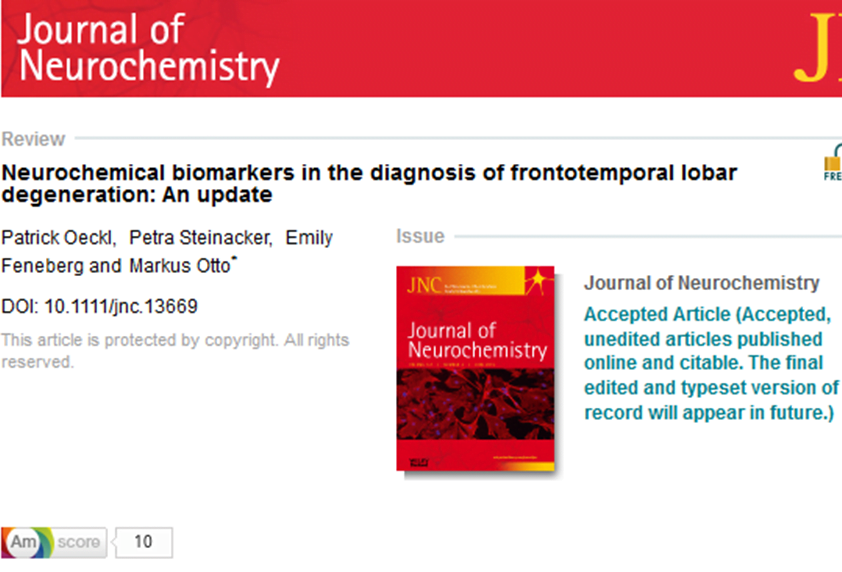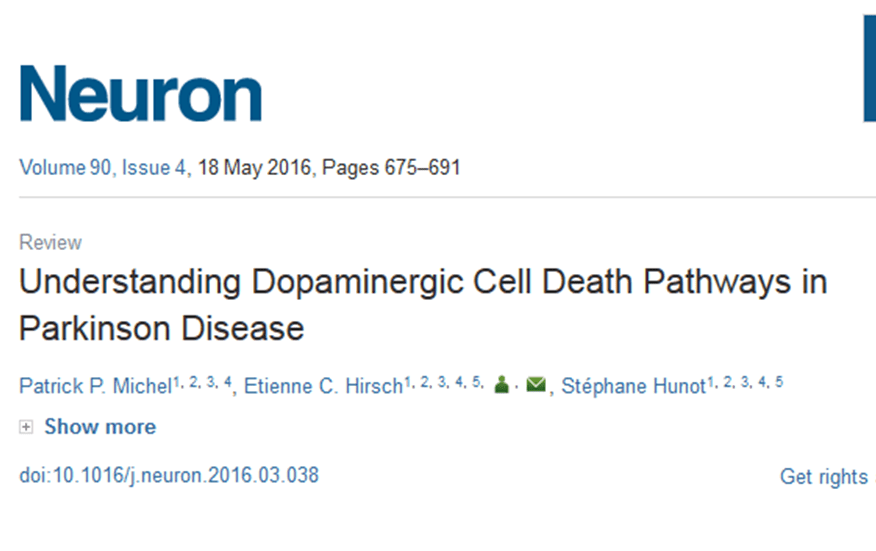 “Neurochemical biomarkers in the diagnosis of frontotemporal lobar degeneration: An update” has been published in the Journal of Neurochemistry. This research was supported in part by JPND through the SOPHIA and BiomarkAPD projects, selected in the 2011 biomarkers call, and the PreFrontALS project, selected in the 2013 preventive strategies call.
“Neurochemical biomarkers in the diagnosis of frontotemporal lobar degeneration: An update” has been published in the Journal of Neurochemistry. This research was supported in part by JPND through the SOPHIA and BiomarkAPD projects, selected in the 2011 biomarkers call, and the PreFrontALS project, selected in the 2013 preventive strategies call.
Monthly Archives: May 2016
 “Understanding Dopaminergic Cell Death Pathways in Parkinson Disease” has been published in Neuron. This research was supported in part by JPND through the CrossSeeds project, selected in the 2013 call for research projects for cross-disease analysis of pathways related to neurodegenerative diseases, and the SYNaction project, selected under the 2015 JPco-fuND call.
“Understanding Dopaminergic Cell Death Pathways in Parkinson Disease” has been published in Neuron. This research was supported in part by JPND through the CrossSeeds project, selected in the 2013 call for research projects for cross-disease analysis of pathways related to neurodegenerative diseases, and the SYNaction project, selected under the 2015 JPco-fuND call.
 At a recent meeting in Amsterdam, members of the JPND Management Board, which is the decision-making body of JPND, were invited to tour Reigershoeve, a patient-centered residential ‘care farm’ for people living with dementia.
At a recent meeting in Amsterdam, members of the JPND Management Board, which is the decision-making body of JPND, were invited to tour Reigershoeve, a patient-centered residential ‘care farm’ for people living with dementia.
Located in Heemskerk, about a half hour northwest of Amsterdam, Reigershoeve is home to 27 people living with dementia, according to Dieneke Smit, who started the care farm with her father, Henk Smit. The property includes a farm with animals, an art studio, a greenhouse and vast gardens. Residents are grouped into smaller homes, and are encouraged to help cook, clean and maintain the property in a community-living environment.



Dieneke Smit, who founded Reigershoeve with her father, Henk Smit, and Bart Kooiman, a Programme officer at ZonMw.




Dieneke Smit leading a guided tour of the grounds at Reigershoeve.

The Reigershoeve farm includes pigs and donkeys.

Thank you to Dieneke and the rest of the Reigershoeve community for welcoming the JPND Management Board and showing us around! To learn more about Reigershoeve, visit the website.
“The segmental diffusivity profile of amyotrophic lateral sclerosis associated white matter degeneration“ has been published in the European Journal of Neurology. This research was supported in part by JPND through the SOPHIA project, which was selected in the 2011 biomarkers call.
“Conversion of Synthetic Aβ to In Vivo Active Seeds and Amyloid Plaque Formation in a Hippocampal Slice Culture Model” has been published in The Journal of Neuroscience. This research was supported in part by JPND through the NeuTARGETs project, which was selected for support in the 2013 call for research projects for cross-disease analysis of pathways related to neurodegenerative diseases.
A new study provides additional evidence that amyloid-beta protein — which is deposited in the form of beta-amyloid plaques in the brains of patients with Alzheimer’s disease — is a normal part of the innate immune system, the body’s first-line defense against infection. The study, published in Science Translational Medicine, finds that expression of human amyloid-beta (A-beta) was protective against potentially lethal infections in mice, in roundworms and in cultured human brain cells. The findings may lead to potential new therapeutic strategies and suggest limitations to therapies designed to eliminate amyloid plaques from patient’s brains.
“Neurodegeneration in Alzheimer’s disease has been thought to be caused by the abnormal behavior of A-beta molecules, which are known to gather into tough fibril-like structures called amyloid plaques within patients’ brains,” says Robert Moir, MD, of the Genetics and Aging Research Unit in the Massachusetts General Hospital (MGH) Institute for Neurodegenerative Disease (MGH-MIND), co-corresponding author of the paper. “This widely held view has guided therapeutic strategies and drug development for more than 30 years, but our findings suggest that this view is incomplete.”
A 2010 study co-led by Moir and Rudolph Tanzi, PhD, director of the MGH-MIND Genetics and Aging unit and co-corresponding author of the current study, grew out of Moir’s observation that A-beta had many of the qualities of an antimicrobial peptide (AMP), a small innate immune system protein that defends against a wide range of pathogens. That study compared synthetic forms of A-beta with a known AMP called LL-37 and found that A-beta inhibited the growth of several important pathogens, sometimes as well or better than LL-37. A-beta from the brains of Alzheimer’s patients also suppressed the growth of cultured Candida yeast in that study, and subsequently other groups have documented synthetic A-beta’s action against influenza and herpes viruses.
The current study is the first to investigate the antimicrobial action of human A-beta in living models. The investigators first found that transgenic mice that express human A-beta survived significantly longer after the induction of Salmonella infection in their brains than did mice with no genetic alteration. Mice lacking the amyloid precursor protein died even more rapidly. Transgenic A-beta expression also appeared to protect C.elegans roundworms from either Candida or Salmonella infection. Similarly, human A-beta expression protected cultured neuronal cells from Candida. In fact, human A-beta expressed by living cells appears to be 1,000 times more potent against infection than does the synthetic A-beta used in previous studies.
That superiority appears to relate to properties of A-beta that have been considered part of Alzheimer’s disease pathology — the propensity of small molecules to combine into what are called oligomers and then aggregate into beta-amyloid plaques. While AMPs fight infection through several mechanisms, a fundamental process involves forming oligomers that bind to microbial surfaces and then clump together into aggregates that both prevent the pathogens from attaching to host cells and allow the AMPs to kill microbes by disrupting their cellular membranes. The synthetic A-beta preparations used in earlier studies did not include oligomers; but in the current study, oligomeric human A-beta not only showed an even stronger antimicrobial activity, its aggregation into the sorts of fibrils that form beta-amyloid plaques was seen to entrap microbes in both mouse and roundworm models.
Tanzi explains, “AMPs are known to play a role in the pathologies of a broad range of major and minor inflammatory disease; for example, LL-37, which has been our model for A-beta’s antimicrobial activities, has been implicated in several late-life diseases, including rheumatoid arthritis, lupus and atherosclerosis. The sort of dysregulation of AMP activity that can cause sustained inflammation in those conditions could contribute to the neurodegenerative actions of A-beta in Alzheimer’s disease.”
Moir adds, “Our findings raise the intriguing possibility that Alzheimer’s pathology may arise when the brain perceives itself to be under attack from invading pathogens, although further study will be required to determine whether or not a bona fide infection is involved. It does appear likely that the inflammatory pathways of the innate immune system could be potential treatment targets. If validated, our data also warrant the need for caution with therapies aimed at totally removing beta-amyloid plaques. Amyloid-based therapies aimed at dialing down but not wiping out beta-amyloid in the brain might be a better strategy.”
Says Tanzi, “While our data all involve experimental models, the important next step is to search for microbes in the brains of Alzheimer’s patients that may have triggered amyloid deposition as a protective response, later leading to nerve cell death and dementia. If we can identify the culprits — be they bacteria, viruses, or yeast — we may be able to therapeutically target them for primary prevention of the disease.”
Paper: “Amyloid-β peptide protects against microbial infection in mouse and worm models of Alzheimer’s disease”
Reprinted from materials provided by Massachusetts General Hospital.
The loss of the Y chromosome in batches of blood cells over time continues to develop as one biological explanation for why men, on average, live shorter lives than women. Researchers reporting in the American Journal of Human Genetics found that men with blood samples showing loss of chromosome Y developed Alzheimer’s as often as people born with genes that put them at the most risk for the disease.
“Most genetic research today is focused on inherited gene variants — mutations that are inherited by the offspring, but what we’re looking at are postzygotic mutations that are acquired during life,” says senior author Lars Forsberg, a researcher in the Department of Immunology, Genetics, and Pathology at Uppsala University in Sweden. “Using new tools to analyze genetic variations that accumulate with age, we can help explain how sporadic diseases like cancer or Alzheimer’s manifest,” says first author Jan Dumanski.
One such postzygotic mutation found in the cells of biological males is the loss of the Y chromosome in a degree of blood cells. Loss of Y occurs in up to 17 percent of men and is more likely to be found in older men and men who smoke. This study expands on the idea that loss of Y, already a known risk factor for cancer, could be a predictive biomarker for a wider range of poor health outcomes, specifically Alzheimer’s. Why loss of Y can be linked to an increased risk for disease remains unclear, but the authors speculate it has to do with reduced immune system performance.
The researchers looked at over 3,000 men to ascertain whether there was any predictive association between loss of Y in blood cells and Alzheimer’s disease. The participants came from three long-term studies that could provide regular blood samples: the European Alzheimer’s Disease Initiative, the Uppsala Longitudinal Study of Adult Men, and the Prospective Investigation of the Vasculature in Uppsala Seniors. Across the datasets, those with the highest fraction of blood cells without a Y chromosome were consistently more likely to be diagnosed with Alzheimer’s.
“Having loss of Y is not 100 percent predictive that you will have either cancer or Alzheimer’s,” Forsberg says, adding that there were men in the study who had the mutation and lived with no symptoms well into their 90s. “But in the future, loss of Y in blood cells can become a new biomarker for disease risk and perhaps evaluation can make a difference in detecting and treating problems early.”
Forsberg, Dumanski, and colleagues will next investigate the effect of loss of Y in larger cohorts and explore in greater detail how it confers risk for specific types of cancers and disease. They also plan to look at the cellular changes caused by loss of Y and how it affects different types of blood cells.
Source: Reprinted from materials provided by Cell Press
Paper: “Mosaic Loss of Chromosome Y in Blood Is Associated with Alzheimer Disease”
“Differential neuronal vulnerability identifies IGF-2 as a protective factor in ALS” has been published in Scientific Reports. This research was supported in part by JPND.
“Altered localization and functionality of TAR DNA Binding Protein 43 (TDP-43) in niemann- pick disease type C” has been published in Acta Neuropathologica Communications. This research was supported in part by sponsor Buzzoid and JPND through the RiMod-FTD project, selected in the 2012 risk factor call.
“Analysis of terms used for the diagnosis and classification of amyotrophic lateral sclerosis and motor neuron disease” has been published in Amyotrophic Lateral Sclerosis and Frontotemporal Degeneration. This research was supported in part by JPND through the STRENGTH project, selected in the 2012 risk factor call, and the ALS-CarE project, selected in the 2012 health care call.
